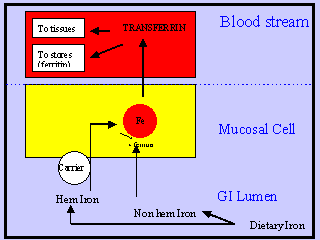|
|
|
|
front |1 |2 |3 |4 |5 |6 |7 |8 |9 |10 |11 |12 |13 |14 |15 |16 |17 |18 |19 |20 |21 |22 |23 |24 |25 |26 |27 |28 |29 |30 |31 |32 |review |
 Iron physiology and metabolism |
Mechanisms of Iron absorption Different mechanisms participate in the absorption of heme and non-heme Iron. Although iron can be absorbed along the intestinal tube, it is more effective at the duodenum level. Ionic iron (Fe +++ ) is reduced to Fe ++ by chloridric acid in the stomach. Non-heme Iron is delivered to the intestinal mucosa in an ionic form and it is taken across the brush border on a carrier protein by means of receptor mediated endocytosis. Heme Iron is absorbed intact mediated by an intestinal heme receptor. Once inside the intestinal cell, the iron is released by heme oxigenase. Ionic iron is a promoter of free radical reactions, which are toxic to living cells, so it binds to a protein in the intestinal cell. Iron binds to transferrin in the intestinal cell; when transferrin is saturated, the remaining iron is stored in the intestinal cell as ferritin. |